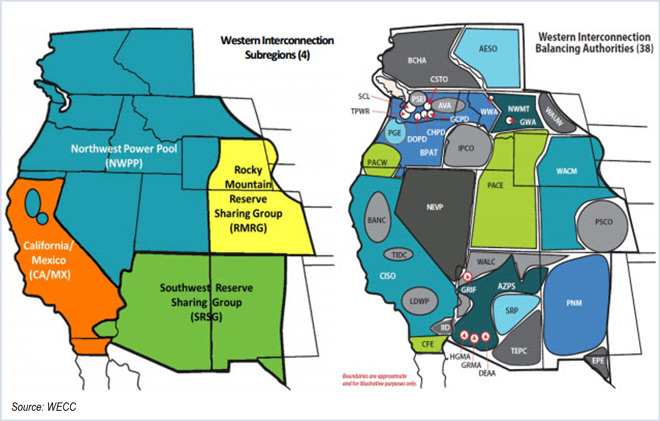By Robert Mullin
PacifiCorp and NV Energy can sell power into the Western Energy Imbalance Market (EIM) at market-based rates, FERC has ruled, reversing a previous finding that had restricted the companies to submitting only cost-based offers (ER17-2934).
The commission imposed the restrictions in late 2015 after finding the two Berkshire Hathaway Energy affiliates had failed to prove that they wouldn’t exercise horizontal market power within the market. At the time, the EIM comprised only the CAISO, PacifiCorp-East (PACE), PacifiCorp-West (PACW) and NVE balancing authority areas (BAAs). It now includes Arizona Public Service, Puget Sound Energy and Portland General Electric.
In their August joint filing with FERC, PacifiCorp and NVE said that the bidding restrictions were “no longer appropriate” because both companies now meet conditions for EIM participation set out in previous FERC orders. They also contended that reliance on cost-based bids ran “contrary to organized market design” and presented the risk of unrecovered costs during some market intervals. (See Berkshire Companies Request EIM Rate Authority.) The utilities contended that the restrictions have created inefficiencies in how they manage hydroelectric resources and respond to intraday fluctuations in natural gas prices.
The companies also provided FERC with analysis by Charles Rivers Associates (CRA) demonstrating there has been little congestion between EIM BAAs since the entry of NVE into the market, supporting the argument that member BAAs should not be considered submarkets subject to market power — a key concern for FERC.
The CRA analysis examined EIM price data from December 2015 to November 2016 to determine the frequency of price discrepancies between CAISO and other EIM BAAs — an indicator of transmission constraints that could warrant concerns about local market power.
CRA’s conclusion: In the 15-minute market, transmission paths appeared to be congested enough to create price separation only 0.7 to 2.4% of the time depending on the BAA; the five-minute market experienced congestion during 0.3 to 6.2% of all intervals, with the higher percentage representing periods when prices deviated by just 1 cent/MWh, what FERC called a “conservative” threshold to test for price separation.
In its Oct. 30 ruling, FERC said it had corroborated those findings.
“We have reviewed this analysis and determined the methodology to be acceptable for an EIM submarket analysis,” the commission wrote. “The commission has previously found that binding constraints in 2.2% of all study hours during an 18-month study period is insufficient evidence to support the existence of a submarket. The price separation instances in this case, which are used here as an indication of binding constraints, are generally in the 2% range, which would indicate a lack of a submarket.”
The commission additionally determined that, having demonstrated the lack of submarkets in the EIM, the two companies have prepared their pivotal supplier and wholesale market share screens consistent with FERC requirements.
“Accordingly, we find it appropriate to lift the default energy bid restriction and allow the Berkshire EIM sellers to bid into the EIM at market-based rates without restriction,” the commission said.
FERC’s decision should help relieve the two companies’ broader market restrictions in the interior West. Last year, the commission also revoked authorization for 21 BHE affiliates, including PacifiCorp and NVE, to sell power at market-based rates in the PACE, PACW, Idaho Power and NorthWestern Energy BAAs. (See Berkshire Market-Based Sales Restricted in 4 Western BAAs.)
While that order still stands, the two companies will immediately have a freer hand to effectively bid power into PACE and PACW through the EIM, and will gain similar access to Idaho Power’s territory starting next April when that utility joins the market.





